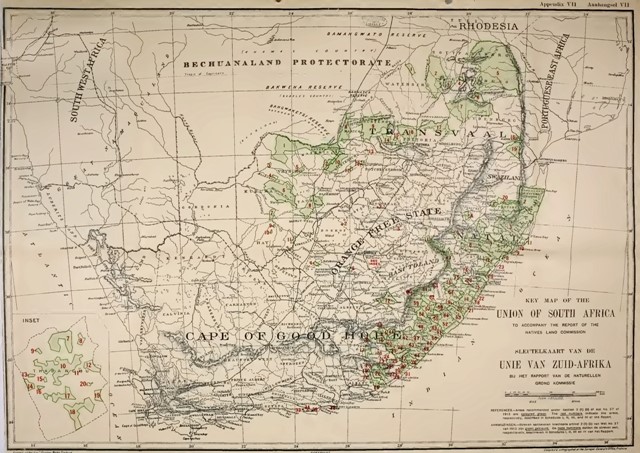Posted on 17 Julie 2019 by volksvryheid
Segregation was created in 1854 by the traditional leaders and Lord
Shepstone (policy) in London. The great media and other propaganda lies
told against apartheid countermanded: In 1988, a German book (The lie
of apartheid and other true stories from Southern Africa) reported
how benevolent the “White Giant of Africa’ actually had been under
so-called apartheid. After 1994 and the so-called democratic “rainbow
nation”, the same ethnic groups and even more, are still living either
on Trustland or different CPA’s (Landclaims legislation). It is not
only South Africa, but the whole of Africa and other continents do have
varioius ethnic groups of people and they all differ from each other.
In South Africa the ethnic groups and leaders blame the white minority
people for their own segregation choices.

*
The Transvaal was annexed by Britain in 1900, but guerrilla fighting continued. The Treaty of Vereeniging (1902) ended the war and made the Transvaal (as well as the Orange Free State) a crown colony of the British Empire. During this time, there were already reserve or british crownland in place.
*
Allegations are made by political leaders and supporters, that the previous government (apartheid) (whites) has killed millions of blacks. If it was the case, there would not have been so many blacks today. They all immigrated from the north, not only in 1800 but since 1902.
On the contrary, blacks wiped out themselves at Mfecane wars (1810-35). They still do it today and not only in South Africa. Even in Africa, blacks killing each other and the necklace murder is also in full swing in Africa. Then if they can not live in their own homeland, they just go over the border to the next country.
The numbers prove it, and it has grown even more with immigrants and illegals just walk over and expect everything for free, even the social grants, because there are open borders since 1994.
Nothing has been changed after 1994, only the wording of Homeland changed to Ingonyama Trustland, only for the Zulu people and Richtersveld CPA for the Khoi San peoples, and there are thousands of other separate CPA’s (landclaims and 8840 traditional leaders), by their own choices.
*
Ethnicity
Before colonisation and so-called apartheid in South Africa, the concept of ethnicity was rooted in the ideas of bonds in kinship, biology and ancestry. Ethnicity has been associated with the belief that ethnic groups are extended kinship networks that serve as basic dividing lines within societies, embracing groups differentiated by colour, language, religion and race. In South Africa, ethnicity involved more visible local communities, built on face to face signal of dialect, kinship, status, religion, cultural practices, and on the force of understanding and fear produced by rural isolation.
Ethnicity refers to shared cultural practices, perspectives, and distinctions that set apart one group of people from another. The most common characteristics distinguishing various ethnic groups are ancestry, territorial possession, language, forms of dress, a sense of history and religion. These characteristics were the units of social, economic and political organisations and inter-communal relations. Ethnic differences are not inherited; they are learned. South Africa consists of different ethnic groups located in different rural homelands. They were peasants or self-providing groups and their economy was agriculture. Land was important to the reproduction of social and economic life.
During the colonial and apartheid periods, the Black population of South Africa was divided into major ethnic groups; namely Nguni people which consisted of: Zulu, Xhosa, Ndebele and Swazi, Sotho people which consisted of Northern Sotho (Bapedi), Southern Sotho (Basotho) and Tswana, Shangaan-Tsonga and Venda, as well as Coloured and Afrikaans. There were separate Bantustans for the Zulus, Xhosas, Sothos, Tswanas, Vendas, Pedis and Shangaans. In urban areas, Africans were housed in the urban townships on ethnic lines and received their schooling in ethnic schools. Indians, Coloureds and Africans were also allotted separate schools.
The largest ethnic group in South Africa is the Zulu and the majority of them live in KwaZulu Natal Province and Gauteng Province. The second largest is the Xhosa group; they are located in the Eastern Cape Province and Western Cape Province. South African ethnic groups are also found across South Africa’s boundaries in neighbouring countries. For example, Nguni-speaking Swazi people make up almost the entire population of Swaziland. At least 1.3 million Sesotho speakers live in Lesotho, and more than 1 million people in Botswana speak Tswana. Tsonga and related languages speakers live in Mozambique, and Venda is also spoken by several thousand people in Southern Zimbabwe.
One of the main characteristics of ethnicity is language. In South Africa, there are more than ten languages and others are grouped as Nguni and Sotho languages. IsiZulu, isiXhosa, siSwati and isiNdebele are Nguni languages. Sepedi (Northern Sotho), Sesotho (Southern Sotho) and Setswana (Tswana) are Sotho-Tswana languages. Venda and Tsonga are the other two official languages in South Africa. English and Afrikaans are also official languages spoken in South Africa.
The majority of the White population, about 60 percent is Afrikaans, with many of the remaining 40 percent being of British or European descent. The Coloured population has a mixed lineage, which often comprises the indigenous Khoisan people and White settlers. Most of the Coloured population live in the Northern and Western Cape Provinces, whilst the majority of the Indian population live in KwaZulu-Natal. The Afrikaner population is especially concentrated in the Gauteng and Free State Provinces.
https://www.sahistory.org.za/article/race-and-ethnicity-south-africa
